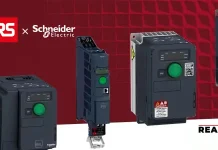In a significant move for the renewable energy and industrial automation sectors, RS Group (RS) has announced the availability of Schneider Electric’s Altivar Solar ATV320 variable speed drives (VSDs) tailored for solar-powered pumping applications. These VSDs are specially engineered to handle highly variable DC voltages from solar arrays-without requiring extensive additional infrastructure like batteries or AC inverters-making them ideal for remote, off-grid, or resource-constrained installations.
What’s New: Altivar Solar ATV320 VSDs
Traditional VSDs are designed for stable AC power supplies. This limitation often complicates their use with solar arrays, which supply variable DC voltages depending on time of day, weather and seasonal conditions. Schneider Electric’s Altivar Solar ATV320 series overcomes this hurdle by accepting a wide DC input voltage range, applying a maximum power point tracking (MPPT) algorithm, and optimizing motor performance automatically.
Key features:
Compatibility with single- and three-phase motors across a range of power ratings (0.37 kW to 15 kW depending on model) and with DC inputs from 150 VDC up to 778 VDC.
Control methods including sensorless vector control, variable torque control, synchronous control, enabling better motor optimization and energy savings.
Remote communication via Modbus, CANopen, Ethernet IP or Modbus TCP, allowing monitoring and controls in distributed systems.
Suited to applications such as irrigation pumping, water treatment, sub-mersible or surface pump systems where solar integration is beneficial.
In summary, RS now offers these solar-driven motor control solutions globally, enabling customers to adopt solar-powered motor systems efficiently.
What are the Implications for the Energy & Power Industry
The recent announcement greatly impacts the energy and power sector. This is especially true for areas like renewable energy, industrial pumps, water systems, and remote operations.
Renewable Energy Integration
Integrating solar arrays to power motors is essential for our decarbonization initiatives. It extends beyond merely generating electricity for the grid. These drives connect solar energy to motor control. This boosts self-sufficiency and reduces reliance on grid or fossil fuel backup power.
Also Read: HD Hyundai and HII Strategic Shipbuilding Memorandum of Agreement
Remote & Off-Grid Applications
Many remote areas, like farms and water treatment plants, often struggle with power. This includes mining sites and infrastructure projects, which usually lack reliable grid power. These drives let solar-powered motors work well without needing batteries or converters. This cuts costs, makes installation easier, and supports sustainable operations.
Energy Efficiency & Cost Savings
One example given: when a pump’s flow is reduced by using a control valve, energy savings may be just 1–2%. But using a VSD to reduce speed instead can save around 27% energy. This level of efficiency supports industrial objectives of lower operational costs and lower carbon footprint.
Industrial Sustainability & Maintenance
Because these drives adapt to solar DC input and eliminate additional components, maintenance burdens drop. For industries seeking lower-maintenance and higher-uptime motor control in remote or harsh environments, this is a meaningful advance.
How will it Affect the Businesses Operating in the Industry
For companies in manufacturing, agriculture, water management, renewable energy, and infrastructure, the availability of solar-solar motor control drives offers both opportunities and considerations:
Opportunities:
Businesses can adopt solar-powered pump systems or motor systems with fewer infrastructure prerequisites, making sustainability more accessible and cost-effective.
System integrators, EPC firms and equipment suppliers can present more compelling turnkey solar-motor solutions to clients, combining solar arrays, Altivar Solar drives and motor control packages.
Industrial firms with large motor fleets (e.g., irrigation, municipal water, mining) can retrofit motors with solar-driven control, reduce energy bills and strengthen ESG credentials.
Challenges & Considerations:
While the drives accept variable DC input, the performance still depends on solar availability. For applications requiring full-speed continuous operation, businesses must assess whether solar alone suffices or if grid/battery augmentation remains needed.
Integration and commissioning still require engineering expertise, applying MPPT algorithms, matching pump/motor equipment and system planning for remote deployment.
Supply chain and support for remote solar motor systems are crucial. Companies need to check vendor support, remote diagnostics, and maintenance logistics. This helps ensure smooth operations.
Conclusion
Renewable energy and decarbonization are booming. Schneider Electric’s Altivar Solar ATV320 drives are fueling this growth. They connect solar power to industrial motors. This conversion makes solar energy usable for motors, pumps, and other industrial tasks.
This technology signals a major shift in the energy sector. It combines solar power with smart motor control. This results in cleaner and more efficient systems.


